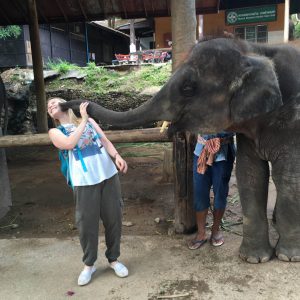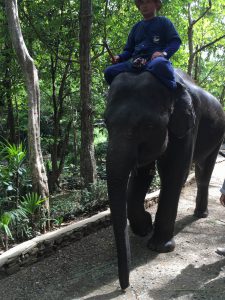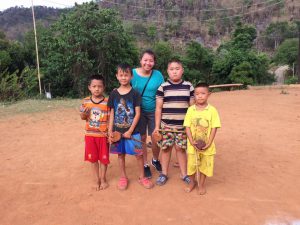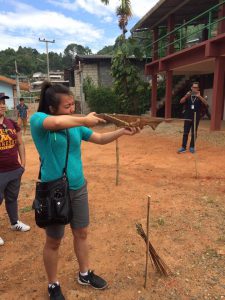What an incredible week it has been in this beautiful country! Each day has held a new adventure and learning experience. Exploring in Bangkok, Thai cooking lessons, monk chatting, school and village visiting, fraternizing with elephants and spending quality time with some old souls of Thailand are just a few of the experiences that have moved me in the short time I have been here. Throughout all of these activities, one key aspect of the Thai culture has stood out to me the most. The prominent role that spirituality plays in the lives of Thai people has been apparent to me since I landed in Bangkok.
While driving to my hotel from the airport upon landing in Bangkok, the first thing I noticed about this country was the attention to detail surrounding artifacts of significance to the Thai culture. Right away, I could tell spirituality was a huge part of their lives. The highway was decorated with well-tended flower boxes displaying a large, gold Buddha. As we drove deeper into the city, I kept noticing beautifully decorated little houses outside of every building and home. I figured these houses were praying stands for those practicing Buddhism. However, I learned they are called spirit houses and are not part of the religion.
I was informed by my Thai cooking instructor that the people of Thailand believe spirits protect their buildings and houses. They put spirit houses outside on the property and decorate them with flowers and bright colors. These houses provide a place for the people to leave an offering for the spirits who protect them. Thai people leave water and fruits on the stands of these houses for the spirits that inhabit them. This is how the people give thanks to the spirits for protecting them from harm and bad luck.
What I find most interesting about these spirit houses is the placement of them. They can be found outside of every facility in Thailand. I think it is so unique to have such an ornate structure amidst such an ordinary setting. Concrete, advertising and garbage surround these beautiful spirit houses. I have even seen them under large trees and on the outskirts of forested areas. It shows that spiritual belief holds very strong to the people of Thailand. Even as the country moves towards globalization, the people hold on to the spirituality that outlines their culture.
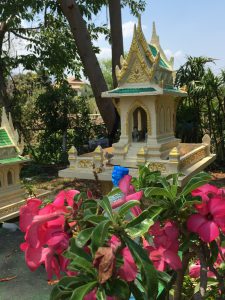

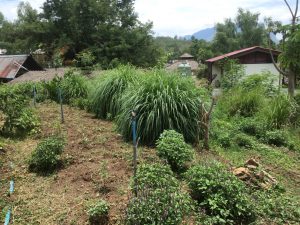
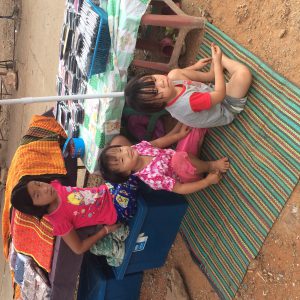 In just the past few days, I feel as though I have gained so much life experience and so much insight into the way in which others live and perceive the world. Through the monk chat to the Hmong village, we have already observed the lives of others immensely that we can apply to the Human Ecological Model. The Human Ecological Model consist of four lenses: the sociocultural, the family, the human built environment, and the natural built environment. The experience that I have chosen to apply to this model is the visit to the Hmong village. In the Hmong village it was facinating to observe how the homes were built into the mountains and structured around the natural enviorment and the way in which they adapted to the nature that surrounded them. The crop designs and green house were built around stairs that were structured specifically to avoid erosion. This displays the human built environment, how the people built their lives around the nature. It was such a profound experience to observe how the village acted as a collective family with smaller units within it. The village survived and thrived based on the connections they had with one another. Every individual portrayed strong family values, they took pride in their village and the simplicity it was made up of. I felt that when they spoke about their village and then way they live it was almost as if they were privileged to have this village, to have the opportunity to live simply, without materialism, without chaos. To have this extremely rare and unique opportunity all to themselves. There was an interdependence within the family, the sociocultural, and the human built environment lenses. How they only went to the city when they didn’t have a choice, for necessities such as education and essential economic resources. Even when the young adults went off to college, they were eager to return once they were finished their four years Eager to return to the solitude, the nature, and the simplicity and peace that they found only in their village.
In just the past few days, I feel as though I have gained so much life experience and so much insight into the way in which others live and perceive the world. Through the monk chat to the Hmong village, we have already observed the lives of others immensely that we can apply to the Human Ecological Model. The Human Ecological Model consist of four lenses: the sociocultural, the family, the human built environment, and the natural built environment. The experience that I have chosen to apply to this model is the visit to the Hmong village. In the Hmong village it was facinating to observe how the homes were built into the mountains and structured around the natural enviorment and the way in which they adapted to the nature that surrounded them. The crop designs and green house were built around stairs that were structured specifically to avoid erosion. This displays the human built environment, how the people built their lives around the nature. It was such a profound experience to observe how the village acted as a collective family with smaller units within it. The village survived and thrived based on the connections they had with one another. Every individual portrayed strong family values, they took pride in their village and the simplicity it was made up of. I felt that when they spoke about their village and then way they live it was almost as if they were privileged to have this village, to have the opportunity to live simply, without materialism, without chaos. To have this extremely rare and unique opportunity all to themselves. There was an interdependence within the family, the sociocultural, and the human built environment lenses. How they only went to the city when they didn’t have a choice, for necessities such as education and essential economic resources. Even when the young adults went off to college, they were eager to return once they were finished their four years Eager to return to the solitude, the nature, and the simplicity and peace that they found only in their village. 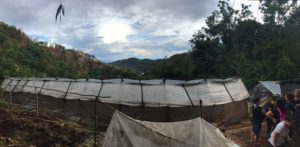
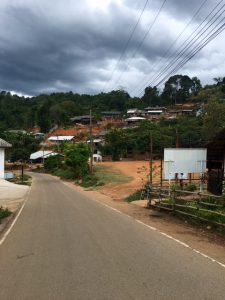 cultural practice informed by nature.
cultural practice informed by nature.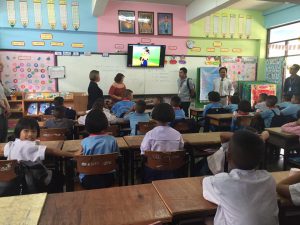

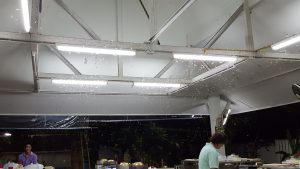 reaking out, the instructor kept her calm and continued to teach us how to cook. I felt like it was a very busy moment because everything and everyone was so chaotic with the insects. There were moths landing in the instructor’s hair, near her face, the food, on the people in the audience, and everywhere that I could think of, she and her husband kept going and did not lose control. Even though I was terrified and scared, I noticed how smooth and controlled she continued to talk. They took the situation really well and I felt like their harmonious reaction influenced everyone else calm down.
reaking out, the instructor kept her calm and continued to teach us how to cook. I felt like it was a very busy moment because everything and everyone was so chaotic with the insects. There were moths landing in the instructor’s hair, near her face, the food, on the people in the audience, and everywhere that I could think of, she and her husband kept going and did not lose control. Even though I was terrified and scared, I noticed how smooth and controlled she continued to talk. They took the situation really well and I felt like their harmonious reaction influenced everyone else calm down.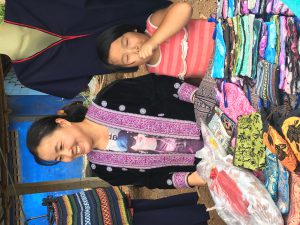 Pride is a common thread that runs through Thai culture. I’ve seen the pride of ethnicity, culture, food, and nature in a handful of interactions this past week. In the Hmong village, the village leader spoke of his community with great love and conviction. He praised their ability to peacefully coexist within a religiously diverse space, their sustainable agricultural practices that pave the way for other hill tribes, and the impenetrable bond that allows the youth to study in the city but then feel moved to return. Shamefully, I must admit that when I was walking around the village I felt impressed but also very sure I wouldn’t want to reside there. HOWEVER, I also came to the realization that the people in this community CHOOSE to live here.
Pride is a common thread that runs through Thai culture. I’ve seen the pride of ethnicity, culture, food, and nature in a handful of interactions this past week. In the Hmong village, the village leader spoke of his community with great love and conviction. He praised their ability to peacefully coexist within a religiously diverse space, their sustainable agricultural practices that pave the way for other hill tribes, and the impenetrable bond that allows the youth to study in the city but then feel moved to return. Shamefully, I must admit that when I was walking around the village I felt impressed but also very sure I wouldn’t want to reside there. HOWEVER, I also came to the realization that the people in this community CHOOSE to live here. Throughout our time here in Thailand so far, I’ve noticed how different the markets and interactions between consumers and vendors are from the United States. The most prevalent difference is the presence of open air markets. These take the form of food markets (mostly for those living here) and markets like the Night Bazaar catered to the tourism sector. By looking at the differences between these two markets, one can see a huge differentiator between American and Thai culture: materialism.
Throughout our time here in Thailand so far, I’ve noticed how different the markets and interactions between consumers and vendors are from the United States. The most prevalent difference is the presence of open air markets. These take the form of food markets (mostly for those living here) and markets like the Night Bazaar catered to the tourism sector. By looking at the differences between these two markets, one can see a huge differentiator between American and Thai culture: materialism.